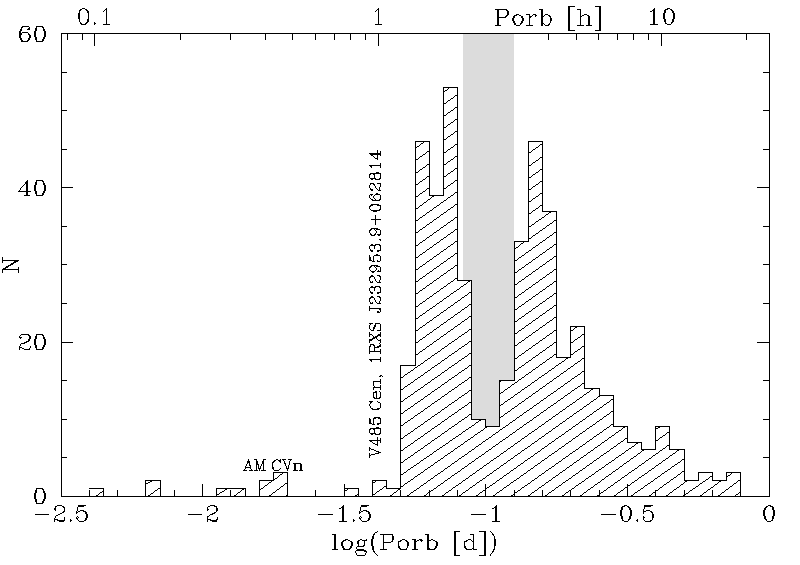
Background
For almost two decades, the general approach to the theory of cataclysmic variable (CV) evolution and the observational picture co-existed quite peacefully despite some disagreements (Patterson 1984), and the progress on both fronts was steady, but slow. The best-known binary parameter of a CV is typically its orbital period, and much of the theoretical effort has been devoted to a quantitative description of the observed orbital period distribution (Figure 1). The pronounced features of this distribution are (1) a dwindling number of CVs at long orbital periods, (2) a dearth of systems in the 2-3h orbital period range (the period gap), and (3) a sharp cut-off at 80min.

The standard CV evolution scenario, disrupted magnetic braking
(e.g., King 1988), can qualitatively explain all three features. The
basic concept of this theory is that the evolution of CVs, from long to
short orbital periods, is divided into two main phases depending on the
prevailing angular momentum loss mechanism. Stellar magnetic braking
dominates in CVs whose Roche-lobe filling donor stars still have a
radiative core, which is the case for orbital periods Porb>3h. Once
the donor stars become fully convective at Porb 3h, magnetic
braking ceases. For Porb<3h gravitational radiation takes over as a
much less efficient angular momentum loss mechanism, resulting in longer
evolution time scales. As a consequence of the high mass loss rate in
the magnetic braking regime, the donor stars in CVs with Porb>3h are
somewhat expanded. The mass loss rate decreases when magnetic braking
ceases at Porb 3h, and the donor star reacts by relaxing to its
thermal equilibrium configuration with a radius that is smaller than its
Roche-lobe radius. As a result, the mass transfer shuts off completely,
and the CV becomes an inactive detached white dwarf/M-dwarf binary that
evolves towards shorter periods through emission of gravitational
radiation. At Porb 2h, the secondary fills again its Roche volume
and re-starts the mass transfer (though at a much lower rate than in
the long-period CVs).
However, a number of predictions of this standard model are in strong disagreement with the observations:
- The predicted minimum orbital period is 65-70min, 10% shorter than the observed value (Kolb & Baraffe 1999).
- CVs should spend most of their lifetime near the minimum period, increasing the discovery probability for such systems. Population syntheses predict a significant accumulation of systems near the minimum period, which is not observed (Kolb & Baraffe 1999).
- While all population syntheses predict that 95% of the entire CV population should have orbital periods <2h (Howell et al. 1997), similar numbers of CVs are observed above and below the period gap. This latter point is closely related to the long-lasting debate on the actual space density of CVs: we currently know only a very small fraction ( 1-10%) of the CVs predicted by the population models (e.g. de Kool 1992 or Howell et al. 2001 vs. Patterson 1998).
- There is no observational evidence for a discontinous change in the spin-down rate due to magnetic braking between late-type field stars that are fully convective and those that have a radiative core (e.g. Sills et al. 2000).
It seems to be quite clear that either our theoretical understanding of CV evolution is missing a fundamental ingredient, or that the known CV sample is dramatically biased and incomplete - or both. Resolving the discrepancies between the theoretical predictions and the observed properties of the CV population is not only crucial for our understanding of CV evolution, but it bears significant importance for related objects, such as low mass X-ray binaries or millisecond pulsars, and for close binary stars in general.
Completeness of the currently known CV population -
or: how to find CVs
CVs are discovered by various means:
- Variability. As suggested by their name, variability is one
of their main features, this is especially true for classical nova and
dwarf novae with sudden brightness variations of up to 10 magnitudes
(Figure 2). Consequently, the bulk of the known CVs has been
discovered by legions of amateur observers relentlessly scanning the
skies for new stars, or by large-scale photographic sky patrols.
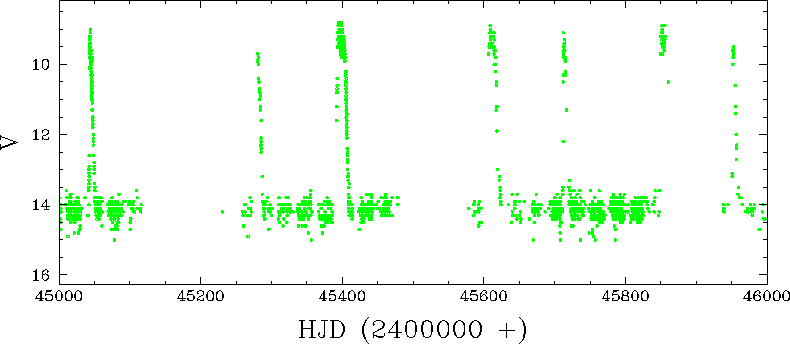
- X-ray emission. Because the mass transfer from the secondary star onto the white dwarf releases a large amount of potential energy, CVs can be detected as X-ray emitters, in particular magnetic CVs, in which the bulk of the energy release is confined to a rather small volume near the magnetic pole caps of the white dwarf (polars, intermediate polars). The various X-ray satellite missions have discovered somewhat more than 100 CVs, the majority during the RASS (e.g. Beuermann et al. 1999).
- Blue colour. As CVs typically contain a hot component (accretion disc/column, white dwarf), they show up as blue/ultraviolet excess objects in colour surveys, such as the Palomar-Green (Green et al. 1982; Ringwald 1996) survey. However, the colour space confusion of CVs with other blue objects (white dwarfs, subdwarfs, QSOs) makes the definite classification of CV candidates very telescope time consuming. To date, less than 100 CVs have been discovered in pure colour surveys.
- Emission lines. Finally, CVs may be discovered thanks to their particular spectroscopic appearance: most CVs show relatively strong Balmer and helium emission lines. Despite a great potential, this selection criterion has been used only to a very limited extent, primarily using the first and second Byurakan surveys, and resulted in the discovery of a handful of CVs.
A large-scale search for new CVs
In 2000 we initiated a systematic search for new CVs, selecting candidates on the base of their spectroscopic properties in the Hamburg Quasar Survey (HQS).1. Figure 3 shows the HQS density spectra of one previously known CV, the dwarf nova T Leo, and one of the new CVs discovered in this project, the deeply eclipsing dwarf nova HS0907+1902. It is apparent that Balmer emission, the hallmark of most CVs, can easily be detected in the HQS spectra for equivalent widths >10A.
Ultimately, this project will provide a magnitude-limited (13<B<18.5) CV sample covering 13600 square degress at high galactic latitudes. Our survey will be complete for faint CVs (short period systems with low mass transfer rates) out to a distance of 150pc. For bright (long period) systems the survey covers several scale heights above the Galactic plane. The goal of this survey is to derive the intrinsic orbital period distribution of the present-day CV population and to measure the space density of these systems. These results will then be used for a critical test of the CV evolution theory.
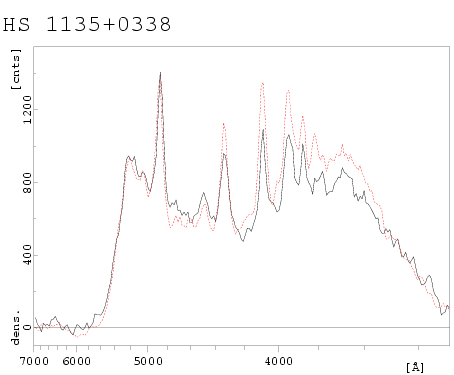
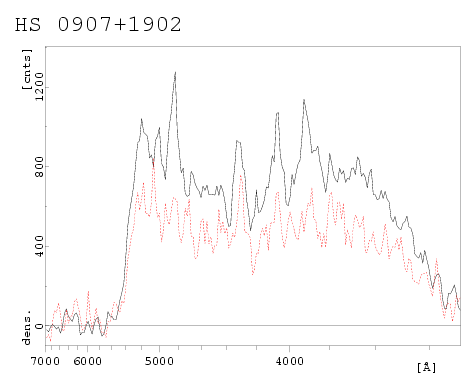
At the time of writing, over 50 new CVs have been discovered in the HQS and about one dozen additional promising CV candidates await spectroscopic confirmation (Araujo-Betancor et al. 2003, Dobrzycka et al. 1998, Gänsicke et al. 2000, Gänsicke et al. 2002b, Jiang et al. 2000, Nogami et al. 2000, Reimers et al. 1999, Reimers & Hagen 2000, Szkody et al. 2001). These new identifications double the number of CVs previously known in the parameter space spanned by the HQS (magnitude range & sky coverage).
Extensive analyses of the previously known CVs that are contained in the HQS demonstrated that we are able to identify CVs with a very high efficiency, especially in the short (Porb<2h) period range (Gänsicke et al. 2002a). A fraction of long (Porb>3h) period CVs with high mass transfer rates are characterised by broad Balmer absorption lines from an optically thick accretion disc, and these systems evade our selection mechanism. Nevertheless, a fair number of such CVs have been discovered in follow-up observations of HQS objects focussed on hot sub-dwarfs and white dwarfs.
Preliminary results on the HQS CV sample
The systems drawn from the HQS represent the first large sample of
spectroscopically identified CVs. In order to compare the properties of
this sample with the predictions of the theoretical models we need to
measure their orbital periods, determine their CV sub-type
(magnetic/non-magnetic), and, if possible, estimate the masses of the
white dwarfs and their donor stars as well as the distance to the
systems. Considering that two to three orbital cycles need to be sampled
to unambiguously determine the orbital period of a CV, this project is
rather demanding in terms of telescope time.
The most reliable way establishing the orbital period of a CV is to measure radial velocity variations of the emission lines, which trace (depending on the type of the CV) the motion of either the accretion/disc or the donor star. For this purpose, we have obtained time-resolved spectroscopy of recently discovered CVs using the Calar Alto 2.2m telescope during two observing runs in December 2002 and April 2003. An example of a radial velocity curve based on CAFOS data is shown in Figure 4.
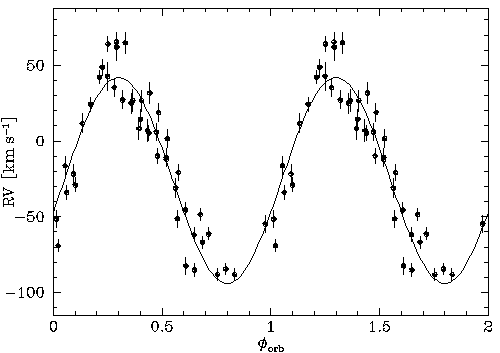
Differential CCD photometry is very useful to characterize additional
properties of the new CVs, and large amounts of data have been obtained
using smaller telescopes located at Braeside Observatory, Kryoneri
Observatory, AIP, and Wendelstein. Combining all available observations
analysed so far, we have currently orbital periods for 26 of the 50
new CVs, and their distribution is shown in Figure 5.
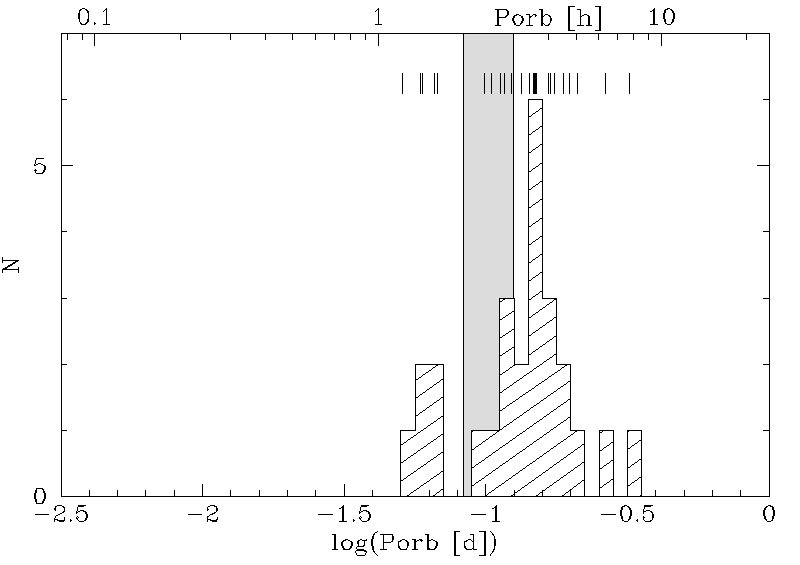
While is is too early to draw definite conclusions, a few preliminary statements can already be made. Comparing this period distribution with that shown in Figure 1, it is apparent that our selection method does not alleviate the problem of the missing short-period CVs described above. In fact, the bulk of our new CVs is found at long orbital period, only four new systems have been identified below the period gap. If the large population of short-period CVs predicted by the theory does exist, these systems must have a very different spectroscopic appearence from the already known short-period CVs. This statement is rather robust, as we could positively identify more than 90% of the previously known short-period CVs contained in the HQS on the base of their density spectra, and we are confident that we have picked up all additional potential short-period systems in our scrutiny of the HQS data base.
The period distribution displays an intriguing concentration of
systems near 4h, most of these CVs are new members of the small
class of SW Sextantis stars, objects with peculiar emission line
behaviour and suspected to contain weakly magnetic white dwarfs. It is
impressive to notice that the SW Sex stars originiating from the
HQS represent 25% of all known SW Sex stars.
Conclusions
We have identified over 50 new CVs based on their spectroscopic properties in the HQS, and 26 of these systems have their orbital period determined. From this sample it is already apparent that the spectroscopic selection of CVs results in a different sample of systems compared to the previous selections based on variability/X-ray emission/blue colours. Data for an additional ~10 systems are currently analysed, and observations of the remaining new CVs are scheduled/planned for fall/winter 2003 and spring/summer 2004. Confronting the characteristics of our spectroscopically selected sample of CVs with both the predictions of the theoretical models as well as with the properties of the currently known ``mixed bag'' of CVs will provide a major step towards a better understanding of CV evolution.
References
K. Beuermann, H.-C. Thomas, K. Reinsch, A. D. Schwope, J. Trümper, W. Voges, 1999, A&A 347
D. Dobrzycka, A. Dobrzycki, D. Engels, H.-J. Hagen, 1998, AJ 115, 1634
B. T. Gänsicke, H. J. Hagen, D. Engels, 2002a, ASP Conf. Ser. 261, 190
H.
Hagen, D. Groote, D. Engels, D. Reimers, 1995, A&AS 111, 195
S. B. Howell, S. Rappaport, M. Politano, 1997, MNRAS 287, 929
S. B. Howell, L. A. Nelson, S. Rappaport, 2001, ApJ 550, 897
X. J. Jiang, D. Engels, J. Y. Wei, F. Tesch, J. Y. Hu, 2000, A&A 362, 263
U. Kolb, I. Baraffe, 1999, MNRAS 309, 1034
M. de Kool, 1992, A&A 261, 188
D. Nogami, D. Engels, B. T. Gänsicke, E. P. Pavlenko, R. Novák, K. Reinsch, A&A 364, 701
J. Patterson, 1984, ApJS 54, 443
J.
Patterson, 1998, PASP 110, 1132
D. Reimers, H. J. Hagen, U. Hopp, 1999, A&A 343, 157
D. Reimers, H. .J Hagen, 2000, A&A 358, L45
H.
Ritter, U. Kolb, 2003, A&A 404, 301
A. Sills, M. H. Pinsonneault, D. M. Terndrup, 2000, ApJ 534, 335
P. Szkody, B. Gänsicke, R. E. Fried, U. Heber, D. K. Erb, 2001, PASP, 113, 1215